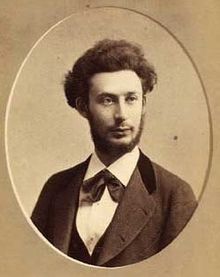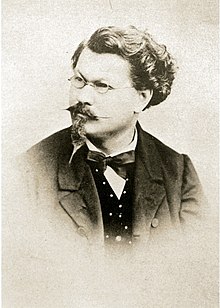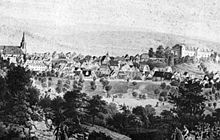Charles Reutlinger
Charles Reutlinger (actually Carl Reutlinger , born February 25, 1816 in Karlsruhe , † June 24, 1888 in Frankfurt ) was a silhouetteur and one of the first German photographers to open a photographic studio in Paris.
Life


Carl Reutlinger was born in Karlsruhe as the fourth child of a Jewish wine merchant and former officer. Through his aunt Weiss, a silhouette urine, he came into contact with this art at the age of 18. He traveled from 1835 to 1849 and initially worked as a silhouetteur. Since 1839 he had citizenship in Karlsruhe. It is not known in which year Reutlinger developed his interest in the daguerreotype . He had his first experiences in the Steinberger & Bauer studio in Frankfurt. Gottlieb Bauer had previously learned photography in Paris. In the years 1847 to 1850, Reutlinger can be identified as a wandering daguerreotypist and photographer.
At the beginning of April 1847, Carl Reutlinger came to Tübingen and stayed in the "Wiedmanschen home", a beer tavern on Stuttgarter Chaussee , which is now Hölderlinstrasse . He offered daguerreotype portraits, which could meanwhile also be made in a room. Additional services were the making of copies of the portraits, also for setting in brooches and rings. In addition to Reutlinger's advertisements, at the beginning of his stay there was a recommendation from the senior real-life teacher Gottlieb Friedrich Kieß, who had already experimented with the daguerreotype several years earlier. Since the prices of the portraits were now lower and the process was simpler, the audience's response was so great that the stay, initially planned for a short time, was extended to two months.
Reutlinger had been in Stuttgart since the beginning of May 1848 at the latest, where he stayed in the former Vetterchen tin factory at Furthbach 8. On May 21, 1848, Reutlinger announced his early departure, but stayed in Stuttgart until May 1849. Despite the difficult time (political tension and unrest), he succeeded. As in Tübingen, Reutlinger praised daguerreotypes that were made in a room, thereby sparking a heated discussion with other Stuttgart daguerreotypes: Israel Käser and Carl Dihm . In contrast to them, who advocated outdoor daguerreotypes, Reutlinger had the financial means to afford the space and the necessary technology. He was on friendly terms with the two of them and with the younger silhouetteur Friedrich Brandseph , whom he initiated into the secrets of photography. The contact continued after Reutlinger went to Paris.
At an unknown point in time, Reutlinger was working in Ulm.
Reutlinger stayed in Augsburg from the end of March 1850 to mid-August 1850. To do this, he had moved into an apartment in front of the Schwibbogentor . Immediately afterwards he moved to Paris.
Reutlinger was born with Therese Weiss married. She gave lessons in making artificial flowers, embroidery and a certain type of coffee roasting, and in 1852 also took lessons in collodion photography . Obviously she supported her husband in his work.
The photographic studio of Ch. Reutlinger
In 1850, Carl Reutlinger settled on Boulevard Saint-Martin , where he opened his first Parisian studio. It was on the sixth floor, had a glass front about 6 m long, the ceiling height was about 3.6 m, faced north and had a sun sail. The glass panes on the roof were matt. There were simple and painted backgrounds, as well as tables, chairs, columns and curtains as additional elements for the design.
From the very beginning he used the wet collodion process there and traded as Charles Reutlinger. He was soon supported by his younger brother Émile Reutlinger , whose son Léopold-Émile Reutlinger and grandson Jean Reutlinger also became well-known photographers.
The later studio was located on Boulevard Montmartre 21, a side studio in Rue Richelieu 121. Reutlinger's studio was popular with its portraits of actors , artists , musicians , composers , opera singers and ballet dancers of his time. Some photographs show the coat of arms of the Kingdom of Great Britain on the reverse . Reutlinger may have photographed members of the royal family. The company name “Ch. Reutlinger ”he had legally protected.
In 1880 the company founder Charles Reutlinger handed the company over to his brother and partner, Émile Reutlinger . The photo studios founded by Charles in Paris were active until 1937. Carl Reutlinger retired to Frankfurt / M on the advice of his doctors. back. Here he was active in the "Association for the Care of Photography and Related Arts in Frankfurt / M.". In 1885 Reutlinger was vice president of the association and honorary member.
Awards
- 1865 a medal (for business card portraits) at the "International Photographic Exhibition" in Berlin,
- 1867 at the "World Exhibition in Paris" and
- 1868 a silver medal for artistic conception and technical perfection in the portrait on the “3. Photographic exhibition ”in Hamburg.
- In 1869 a silver medal (portraits) at the "Exhibition for Photography, Self-Printing and Color Printing" in Groningen / NL.
- 1870 Paris, “Société française de photographie”.
- 1872 Lyon, “Société des Sciences industrielles de Lyon”, gold medal
- 1873 a progress medal for portraits and studies based on nature at the photographic exhibition as part of the “World Exhibition” in Vienna.
- 1874 a medal on the “10. Photographic Exhibition ”in Paris by the Société française de photographie
- 1876 Confirmation of previously awarded medals at the “12. Photographic Exhibition ”in Paris by the Société française de photographie
- In 1878 a silver medal for excellent portrait photography in the photography and photographic apparatus class at the "World Exhibition" in Paris
Memberships
- Member of the Société française de photographie (1862–1880) and in 1867 became its second director.
- 1872 member of the "Photographische Gesellschaft" (Vienna)
- Member of the "Association for the Care of Photography and Related Arts in Frankfurt / M." (Joined before 1882, election as 2nd chairman)
Preserved daguerreotypes from Germany
Tübingen
From his stay in Tübingen from April to May 1847 four works have been preserved that can certainly be attributed to Reutlinger. In some other daguerreotypes from this period, the original reverse with the signature is missing.
- Portrait of the Autenrieth family in unusual portrait format - now heavily oxidized (family property, Stuttgart)
- Portrait of the Baur family ( Stadtmuseum Tübingen , gift from Mathilde Sinner, Paul Sinner's daughter )
- The 20th foundation festival of the " Corps Rhenania " in the garden of the Imperial Eagle (Corps Rhenania archive)
- View of Tübingen from the north, handed down as a template for the clay lithography by F. Schlotterbeck (Stadtmuseum Tübingen)
Reutlingen
- Mid-January 1848 portrait of Nane Nanz, bride and cousin of Vicar CA Beck (120 × 105 mm; with frame 162 × 140 mm; Württembergisches Landesmuseum Stuttgart)
Stuttgart
- July 1848 Portrait of Ludwig Pfau (95 × 70 mm; with frame 147 × 121 mm; Deutsches Literaturarchiv Marbach )
- 1848 Friedrich von Böhm with his bride and brother-in-law. (Cologne, Museum Ludwig , Photography Collection, (Cultural Heritage Cologne), online )
See also
Secondary literature
- Hartmann: Emil Rheinstädter and Carl Reutlinger † . In: Photographische Korrespondenz , Vol. 25, Vienna 1888, pp. 355–357
- G. [eorge] W. [harton] Simpson: Repertory . Visits to notable studios. M. [onsieur] Reutlinger's studio in Paris . In: Photographische Korrespondenz , VI. Vol., 1869, pp. 104f. and p. 182f.
- Ch.Rutlinger: The Reutlinger Studio . In: The Philadelphia Photographer , Vol. VI., Benerman & Wilson, Philadelphia 1869, pp. 115-116, pp. 258-260
- Hermann Vogel : Walks through the Paris studios . I. Reutlinger. In: Photographische Mitteilungen , 4th vol., Louis Gerschel, Berlin 1868, pp. 129–132
literature
- Franz Häußler: Photography in Augsburg 1839 to 1900 , Wißner, Augsburg 2004, ISBN 3896394320 , pp. 29-30
- Wolfgang Adler: The beginnings of photography in Ulm . In: Ulm in the 19th century . Kohlhammer, Stuttgart 1990, ISBN 3-17-011198-1 , pp. 519-567
- Wolfgang Hesse: Views from Swabia. Art, country and people in photos by the first Tübingen photographers and the photographer Paul Sinner (1838–1925) , Metz brothers: Tübingen 1989, ISBN 3-921580-79-X
- Joachim W. Siener: The photography and Stuttgart 1839-1900. From the masked sleigh ride to the court photographer , Cantz edition: Stuttgart 1989, ISBN 3-89322-150-6
- Jutta Reinke; Wolfgang Stemmer (ed.): Pioneers of the camera ... , photo forum: Bremen o. J. [1988]
- Robert Lebeck (ed.): The beauties of Paris ... , Dortmund 1981 (The bibliophile paperbacks No. 227)
- Jean-Pierre Bourgeron: Les Reutlinger. Photographes à Paris 1850–1937 , Grove art: Paris 1979, ISBN 2-903097-02-X
Notes and individual references
- ↑ In a small obituary notice from Photographische Mitteilungen . 25th vol., 1889, p. 96 is given as the date for the death of June 25th.
- ↑ a b Joachim W. Siener: Die Photographie and Stuttgart 1839-1900 , p. 78.
- ^ Johann Gottlieb Bauer, son of the Frankfurt painter Philip Jacob Bauer.
- ^ Frankfurter Kunstverein (ed.), Heinrich Weizsäcker: Art and Artists in Frankfurt am Main in the Nineteenth Century , Volume 1, Baer, Frankfurt 1909, p. 7.
- ↑ Wolfgang Hesse: Views from Swabia ... , p. 18. Reutlinger's advertisements appeared in the "Tübinger Chronik" on April 3, 10, 12, 16, 29 and on May 3, 22, 27, and in the “Official Journal” on April 9 and 28, 1847.
- ^ In the "Official Journal" on April 9, 1847 and in the "Tübinger Chronik" on April 16, 1847.
- ↑ Note: Still, photography was still very expensive. A cheapest portrait at Reutlinger cost more than a week's wage for a day laborer.
- ↑ In a two-column advertisement in the "Swabian Chronicle"
- ↑ Joachim W. Siener: Die Photography and Stuttgart 1839-1900 , pp. 79-80
- ↑ Joachim W. Siener: Die Photographie and Stuttgart 1839-1900 , p. 97.
- ^ State bibliography of Baden-Württemberg online . Note: Wolfgang Adler: The beginnings of photography in Ulm .
- ↑ Wolfgang Hesse: Views from Swabia ... , p. 18 with reference to "Schwäbische Kronik" from August 16, 1852, p. 1492
- ↑ Illustration see p. 106 in GW Simpson: Repertorium . Visits to notable studios.
- ^ A b Bibliothèque nationale de France.
- ↑ a b c National Portrait Gallery (London)
- ↑ Photographische Korrespondenz , 22nd year, Vienna 1885, p. 70
- ↑ Photographische Korrespondenz , 22nd year, Vienna 1885, pp. 94, 95
- ↑ Photographische Korrespondenz , 2nd year 1865, p. 218, No. 50
- ↑ Photographische Mitteilungen , 5th vol., 1868, p. 239.
- ↑ Photographische Korrespondenz , 6th year 1869, p. 190
- ↑ Bulletin de la Société Francaise de Photographie , Tome Dix-Septieme, (17th vol.), 1871, Paris, Gauthier-Villars, 1871, p. 11.
- ↑ Photographische Korrespondenz , Vol. 10, 1873, p. 84.
- ↑ Photographische Korrespondenz , 11th vol., 1874, p. 130.
- ↑ Photographische Korrespondenz , Volume 13, 1876, p. 178.
- ↑ Photographische Korrespondenz , Vol. 15, 1878, p. 163.
- ↑ Photographische Korrespondenz , 9th year, 1872, p. 97.
- ↑ Wolfgang Hesse: Views from Swabia ... , p. 19.
Web links
- Reutlinger, Carl (1816-1888). In: Catalog général. Bibliothèque nationale de France , 25 August 2017, accessed on 30 August 2017 .
- National Portrait Gallery (London) : Photos by Charles Reutlinger:
- New York Public Library : Photos by Charles Reutlinger:
- europeana Charles Reutlinger
| personal data | |
|---|---|
| SURNAME | Reutlinger, Charles |
| ALTERNATIVE NAMES | Reutlinger, Carl; Reutlinger, Karl; Reutlinger, C. |
| BRIEF DESCRIPTION | German silhouetteur, as well as Franco-German pioneer of photography |
| DATE OF BIRTH | February 25, 1816 |
| PLACE OF BIRTH | Karlsruhe |
| DATE OF DEATH | June 24, 1888 |
| Place of death | Frankfurt am Main |




